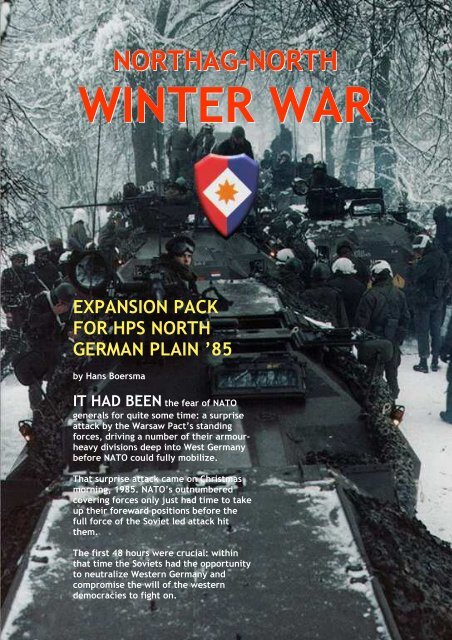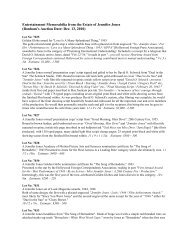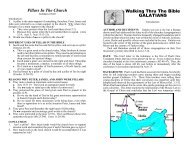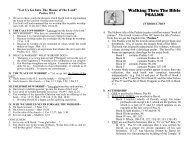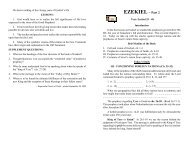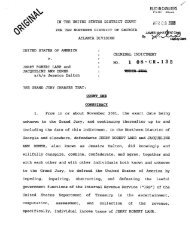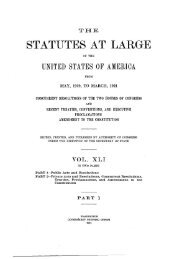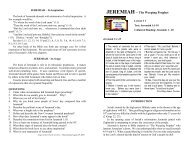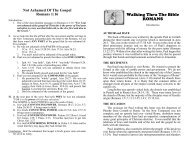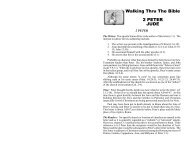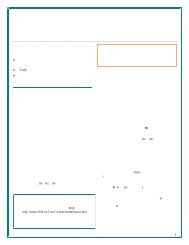WINTER WAR - HiWAAY Information Services
WINTER WAR - HiWAAY Information Services
WINTER WAR - HiWAAY Information Services
You also want an ePaper? Increase the reach of your titles
YUMPU automatically turns print PDFs into web optimized ePapers that Google loves.
NORTHAG-NORTH<br />
<strong>WINTER</strong> <strong>WAR</strong><br />
EXPANSION PACK<br />
FOR HPS NORTH<br />
GERMAN PLAIN ’85<br />
by Hans Boersma<br />
IT HAD BEEN the fear of NATO<br />
generals for quite some time: a surprise<br />
attack by the Warsaw Pact’s standing<br />
forces, driving a number of their armourheavy<br />
divisions deep into West Germany<br />
before NATO could fully mobilize.<br />
That surprise attack came on Christmas<br />
morning, 1985. NATO’s outnumbered<br />
covering forces only just had time to take<br />
up their foreward positions before the<br />
full force of the Soviet led attack hit<br />
them.<br />
The first 48 hours were crucial: within<br />
that time the Soviets had the opportunity<br />
to neutralize Western Germany and<br />
compromise the will of the western<br />
democracies to fight on.
1. Introduction<br />
NORTHAG-North Winter War is an expansion pack for HPS North German Plain ’85 and includes a series of<br />
seven scenarios focussing on the actions of 1 (NL) Corps (1 Legerkorps) during the Warsaw Pact’s Christmas<br />
Offensive of 1985; as such it is an elaboration on the large campaign scenario “Winter War in the NORTHAG<br />
Sector” (#10_08s). The scenarios work with new oob, pdt and unit icon files. Installing these will not<br />
overwrite original files*. All scenarios have AI orders for the Warsaw Pact side only.<br />
2. Additions and Changes<br />
I made a number of changes to files of the types mentioned above, which will be specified below.<br />
2.1 Order of Battle [NG Plain_NN_Dec85.oob]<br />
2.1.1 1 (NL) Legerkorps, NTC, KLu and ACLANT<br />
After researching the organisation of the Netherlands armed forces of the mid-eighties, I introduced the<br />
following additions and changes to the oob.<br />
Additions:<br />
• Anti-tank companies on battalion level<br />
• Combat engineer companies on brigade level<br />
• Engineers, artillery, Royal Constabulary, reconnaissance helicopters and commandos on Corps level,<br />
two reconnaissance battalions on Corps level and one on divisional level<br />
• Troops of the National Territorial Command (NTC) on Corps level<br />
• One mechanised infantry battalion (55 Painfbat) on Corps level<br />
• Three F-16 Squadrons, one of which reconnaissance, and two NF-5 Squadrons to the Royal<br />
Netherlands Air Force (KLu)<br />
• Allied Command Atlantic (ACLANT) on Army level, featuring the Royal Netherlands Marine Corps<br />
(Kmarns), elements of the Royal British and Royal Netherlands Navy (KM) and the United<br />
Kingdom/Netherlands Amphibious Force (UK/NL AMF)<br />
Changes:<br />
• For the unit designations I adopted the official Dutch military abbreviations. Confusing as it initially<br />
might be, I’m confident that the game’s (NATO) symbols and unit pictures leave no doubt about the<br />
function of any unit. Below are most of the unit designations for the Netherlands forces and their<br />
translations:<br />
English Abbrevations In Full, Dutch<br />
Armoured Brigade Pabrig Pantserbrigade<br />
Army Corps Lk Legerkorps<br />
Army Corps Artillery Lka Legerkorpsartillerie<br />
Constabulary Battalion (Military Police) Marbat Marechausseebataljon<br />
Constabulary Company (Military Police) Maresk Marechaussee-eskadron<br />
Engineer Battalion Gnbat Geniebataljon<br />
Infantry Brigade Infbrig Infanteriebrigade<br />
Light Aircraft Group (reconnaissance helicopters) GpLV Groep Lichte Vliegtuigen<br />
Marine Battalion Marnsbat Mariniersbataljon<br />
Marine Corps Kmarns Korps Mariniers<br />
Mechanised Anti-Air Battery Paluabt Pantserluchtdoelartilleriebatterij<br />
Mechanised Artillery Regiment Afdva/Afdra Afdeling Veld-/Rijdende artillerie<br />
Mechanised Engineer Company (combat engineers) Pagncie<br />
Pantsergeniecompagnie<br />
Mechanised Infantry Battalion Painfbat Pantserinfanteriebataljon<br />
Mechanised Infantry Brigade Painfbrig Pantserinfanteriebrigade<br />
Mechanised Support Company (anti-tank) Paostcie Pantserondersteuningscompagnie<br />
National Reserve (Home Guard) Natres Nationale Reserve<br />
* with exception of Supply Unit.bmp (Netherlands), of which the vehicle type has been corrected; you can choose to overwrite or not.<br />
I also included Bradley.bmp (American) as it seems to be missing in the latest HPS patch. The file itself is not changed.
English Abbrevations In Full, Dutch<br />
National Territorial Command NTC Nationaal Territoriaal Commando<br />
Observation and Reconnaissance Company<br />
(commandos)<br />
Wrnverkcie<br />
Waarnemings- en<br />
verkenningscompagnie<br />
Reconnaissance Battalion Verkbat Verkenningsbataljon<br />
Royal Air Force Klu Koninklijke Luchtmacht<br />
Royal Navy KM Koninklijke Marine<br />
Tank Battalion Tkbat Tankbataljon<br />
• The Centurion tanks have been upgraded from Mk3 to Mk5/2 (105mm gun)<br />
• The YP-408 armoured personnel carriers have been flagged as “low reliable”, like the Centurions;<br />
both were only still in use because of budget cuts in the past and were being replaced (with YPR’s<br />
and Leopards respectively). In the mid-eighties their deployability had become questionable<br />
DAF YP-408 armoured personnel carrier<br />
• The Leopard 1 has been relabelled Leopard 1-V; it has also been flagged as “low reliable”, due to<br />
continuous problems with various new (electronic) systems and overdue maintenance of the old<br />
components<br />
• The number of vehicles in the Paluabts (anti-air batteries) has been raised from 6 to 9<br />
• The number of tanks per Tkbat (tank battalion) has been raised from 13 to 17<br />
• 56 Tkbat (non-existent) has been renumbered 58 Tkbat<br />
• 44 Painfbat (mechanized infantry battalion) has been moved from 42 to 52 Painfbrig; 53 Painfbat<br />
has been deleted (non-existent)<br />
• 54 Afdva has been downgraded from M109 to M114 guns<br />
• The unit quality of the KLu (Royal Air Force) squadrons has been raised from D to C. Contrary to the<br />
army, the KLu largely consisted of regulars, with conscripts and reservists only serving in supporting<br />
roles; pilots were partly trained in the US and Canada, and the KLu took pride in being a professional<br />
organisation. During the NATO air operations over former Yugoslavia in the mid-nineties the<br />
KLu turned out to be a highly flexible and effective organisation (USAF Lieutenant General J.W.<br />
Ashy: “The Dutch and American pilots are both top-notch. We have been working together for so<br />
many years, it’s like we’re in the same country […] I was extraordinarily impressed with your pilots<br />
as I am with American pilots. I see little, little difference”). While this might lead us to a B or even<br />
an A rating, in the mid-eighties the KLu struggled with a structural problem: experienced pilots and<br />
technicians were leaving service in considerable numbers for well-paid jobs in commercial airline<br />
companies. Although most of them were called back into service during the general mobilization,<br />
the lack of incorporated experience continued to affect the KLu for several crucial days.
• There are some significant changes in the composition of the armoured units, as is shown in the two<br />
tables below; changes are displayed in blue. In the eighties the Netherlands tank force went<br />
through a huge modernisation programme: the Centurion, in service since the fifties, was being<br />
replaced, while the Leopard 1 was being extensively upgraded to Leopard 1-V, the “V” standing for<br />
“verbeterd” (improved). Further the brand new Leopard 2 entered service from 1983 on. The<br />
modernisation came with reorganisations, one of which was the enlarging of the Tkbats in the<br />
Painfbrigs with a fourth squadron (D), raising the number from 52 to 61 tanks per battalion. In<br />
December 1985 42 Tkbat was the first battalion with an operational D-squadron. Regimental names<br />
have been added in the form of abbreviations which can be viewed in the unit box.<br />
1 (NL) Corps: Tank Battalions (Tkbats)<br />
1 Divisie Tkbat Original NGP85 NN Winter War Regiment Abrv<br />
11 Painfbrig 101 Centurion Leopard 1-V Regiment Huzaren Prins Alexander RHPA<br />
12 Painfbrig 59 Centurion Leopard 1-V Regiment Huzaren Prins van Oranje RHPO<br />
13 Pabrig<br />
49 Leopard 2 Leopard 1-V<br />
11 Leopard 2 Leopard 1-V Regiment Huzaren van Sytzama RHS<br />
4 Divisie Tkbat Original NGP85 NN Winter War Regiment Abrv<br />
41 Pabrig<br />
41 Leopard 2 Leopard 2 Regiment Huzaren Prins Alexander RHPA<br />
43 Leopard 2 Leopard 2 Regiment Huzaren van Sytzama RHS<br />
42 Painfbrig 57 Centurion Centurion<br />
43 Painfbrig 42 Leopard 1 Leopard 2* Regiment Huzaren Prins Alexander RHPA<br />
5 Divisie Tkbat Original NGP85 NN Winter War<br />
51 Pabrig<br />
12 Leopard 1 Leopard 2<br />
54 Leopard 1 Leopard 2<br />
52 Painfbrig 52 Centurion Centurion<br />
53 painfbrig 58 Centurion Centurion *with D-squadron<br />
• As the next table shows the Verkbats have also been updated, sporting a mixture of M113’s and<br />
Leopards, the first roughly composing 2/3rd and the latter 1/3rd of their strength, which has been<br />
increased from 36 to 54 vehicles. The AMX13 went out of service in the late seventies.<br />
1 (NL) Corps: Tanks in the Reconnaissance Battalions (Verkbats)<br />
Verkbat Original NGP85 NN Winter War Regiment Abrv<br />
1 Divisie 104 AMX13 Leopard 1-V Regiment Huzaren van Boreel RHB<br />
4 Divisie 103 AMX13 Leopard 2 Regiment Huzaren van Boreel RHB<br />
5 Divisie 102 AMX13 Leopard 1-V Regiment Huzaren van Boreel RHB<br />
1 (NL) Corps 105 AMX13 Leopard 2 Regiment Huzaren van Boreel RHB<br />
• There are no further changes in the Painfbats; the table below completes the picture with their<br />
regimental names.<br />
1 (NL) Corps: Mechanized Infantry (Painfbats), Regiments<br />
1 Divisie Painfbat Regiment Abrv<br />
11 Painfbrig<br />
12 Garderegiment Jagers GRJ<br />
48 Regiment Van Heutsz RVH<br />
12 Painfbrig<br />
11 Garderegiment Grenadiers GRGR<br />
13 Garderegiment Fuseliers Prinses Irene GRFPI<br />
13 Pabrig 17 Regiment Infanterie Chassé RICH<br />
4 Divisie Painfbat Regiment Abrv<br />
41 Pabrig 42 Regiment Limburgse Jagers RLJ<br />
44 Painfbat moved to 5 Divisie<br />
42 Painfbrig 43 Regiment Infanterie Chassé RICH<br />
45 Regiment Infanterie Oranje Gelderland RIOG<br />
43 Painfbrig<br />
41 Regiment Stoottroepen RST<br />
47 Regiment Infanterie Menno van Coehoorn RIMVC
2.1.2 German 1. Korps<br />
1 (NL) Corps: Mechanized Infantry (Painfbats), Regiments<br />
5 Divisie Painfbat Regiment Abrv<br />
51 Pabrig 16 Regiment Limburgse Jagers RLJ<br />
52 Painfbrig<br />
15 Garderegiment Fuseliers Prinses Irene GRFPI<br />
44 Regiment Infanterie Johan Willem Friso RIJWF<br />
53 painfbrig<br />
14<br />
46<br />
As I added Dutch territorial troops it only seemed logical to do the same for the Germans, as most of the<br />
fighting took place on their soil. For this I used the OOB file produced by Peter Dietrich and added four<br />
Heimatschutz Brigades from NTK (Nordliches Territorialkommando).<br />
3. General Remarks<br />
3.1 Strength<br />
I have made the Netherlands OOB as complete as possible — within the format of the game. This meant<br />
exercising some restraint and having a closer look at the other NATO armies and the way they are represented<br />
in the game. The Paostcie’s for example add substantial anti-armour power to the Painfbats, but it<br />
should be noted that the actual numbers of TOW systems were even higher, with up to 24 systems per<br />
Painfbat. For the OOB I therefore took the game’s US mechanised infantry as guideline, with one company<br />
of 12 systems per battalion. As has been noted above, the Verkbats (reconnaissance battalions) have been<br />
upgraded both in material as in numbers — from 36 to 54 vehicles; the actual number of vehicles however<br />
was 81 (63 M113’s, 18 Leopards), not counting command and staff vehicles. As a final example, the<br />
relatively large Lka (Corps Artillery): I added 9 units, where I could have added 12 (for comparison: in the<br />
OOB West German I. Korps has 10 artillery units on Divisional and Corps level).<br />
The diagram below shows the additions to the Netherlands forces are nonetheless extensive:<br />
Men Guns Vehicles Units Planes<br />
Original NGP85 9140 0 756 129 48<br />
NN Winter War 17826 90 1329 251 162<br />
These numbers make it clear that any scenario makers should use this Netherlands OOB with some prudence;<br />
on Corps level it is probably more expanded than any other in the game, especially in territorial troops<br />
and Corps engineers. I have made these additions to improve accuracy and to add choice, flavour and<br />
variety; not to create a misbalanced game.<br />
All in all, the combat power of 1 (NL) Corps has been increased considerably. The enlargement of the tkbats<br />
from 39 to 51 tanks adds no less than 144 tanks in total, while the upgrading of the Verkbats adds yet more<br />
armour and fire power. The correction of the Centurion tanks from Mk3 to Mk5/2 will also have a noticeable<br />
effect; they retain however a lower speed and defence value to reflect their mechanical unreliability, as<br />
well as the “low reliability” rating.<br />
3.2 The Netherlands Army, Unit Quality<br />
3.2.1 Overview<br />
In the seventies both national and international (NATO) expectations about the wartime effectiveness of<br />
1 (NL) Corps were gloomy: a conscript army, unionised, for a large part depending on reserves, composed of<br />
long-haired soldiers with a very casual military attitude — hardly the picture of a model army. In the late<br />
seventies and early eighties however it became clear that at least in manoeuvres the Dutch performed just<br />
as good as any of their NATO allies; the American Soldiers magazine even concluded that the Dutch<br />
conscript was a “first class soldier” — and “tough as nails” was a qualification heard after joint US-Dutch<br />
manoeuvres. Moreover, Dutch units often scored high in NATO competitions like the Canadian Army Trophy.<br />
In June 1985 the Dutch conscripts of 43 Tkbat (Leopard 2) scored the highest hit percentage (96%) at the<br />
CAT. While all this might lead us to a general B quality rating, the fighting in December 1985 and January<br />
1986 also showed the Dutch weren’t in all cases as enduring as, for instance, German or British troops.<br />
Generally however they fought with spirit, and the inhabitants of Bad Bevensen or Bremen will certainly<br />
remember the bloody fights they put up in defence of their cities.
3.2.2 Changes<br />
The overall unit quality of the Netherlands units is originally C (“average”), which is probably fair if one<br />
would have to rate the Netherlands forces as a whole. I felt however that a bit more profile is possible, and,<br />
in some cases, needed.<br />
3.2.2.1 D Quality: 5 Divisie; the Netherlands Army Reserve System<br />
5 Divisie was composed entirely of reserve units. First it should be noted that in the Netherlands “reserves”<br />
meant something different than in most other countries, where reserve forces tend to be composed of parttime<br />
volunteers (in the Netherlands Army personnel of this sort was to be found in Natres [National Reserve]).<br />
Conscripts who had completed their military service automatically became reservists who could be called<br />
back into active service up to the age of 40 in case of a general mobilization. Personnel that had been in<br />
active service less than two and a half years before would go straight back into operational units (a quite<br />
ingenious system called RIM), the others had to go through a limited period of training again before they were<br />
considered deployable.<br />
In terms of pure reaction speed the Netherlands reserve system was perhaps the most effective in the world.<br />
During yearly mobilisation drills (“Donderslag”) sceptical NATO officials were time and again convinced and<br />
impressed by the speed with which reserve units could be made combat-ready; indeed the Dutch claim that<br />
each of the three reserve brigades could be geared up for departure to its war destination within 24 hours<br />
proved to be a credible one.<br />
In the late seventies 5 Divisie was mechanized, which gave it the same organization and armament as 1 and 4<br />
Divisie. But while on paper 5 Divisie might seem a force equal to the other two divisions, the reality was a different<br />
one; there were to major problems that effected its deployability. Firstly it still needed a considerable<br />
amount of professional NCO’s, and these were simply not available in sufficient numbers. Secondly, and more<br />
importantly, the reserve units lacked recent training, especially in operating on brigade level. Periodically<br />
groups of reservists were called back into service for a short period to keep their training up to a certain<br />
standard, but due to budget restrictions this happened to few and on too small a scale to be really effective.<br />
This meant that after mobilization the division would need at least several weeks of training to be able to<br />
operate on the same level as 1 and 4 Divisie. Reservists were generally highly motivated but it simply needed<br />
time to form them into solid units and to make these units function in the evermore complex combat operations<br />
of larger army formations.<br />
We know that in December 1985 the division only got a few days to prepare itself, and although it performed<br />
relatively well in the area north of Cloppenburg the results could have been much better, especially against<br />
the 2nd echelon Polish Divisions.<br />
The only exception to the downgrading from C to D quality is 44 Painfbat; this was an active battalion of<br />
4 Divisie that in wartime was placed under 5 Divisie’s operational command.<br />
3.2.2.2 B Quality: 41 Pabrig, 41 Gnbat, 103 Verkbat<br />
On the other hand there were the active units permanently stationed in West Germany: an armoured brigade<br />
enforced with a reconnaissance and an engineer battalion. These could be combat-ready in six hours, were<br />
well prepared for their task and knew both the terrain and the forces opposing them. Furthermore it were<br />
mostly these units that scored highest during national and NATO contests like the Bult Francis Cup and the<br />
Canadian Army Trophy. Indeed 41 Pabrig proved to be a tough nut to crack; it took heavy losses during the<br />
campaign but remained an active and effective combat outfit throughout.<br />
3.2.2.3 A Quality Units<br />
These are elite units originally not present in the game: 104 Wrnverkcie (Commandos) and Kmarns (Marines).<br />
Reserve components of these units (305 Cotrbat and 3 Marnsbat respectively) are rated B.<br />
3.2.2.4 C Quality units<br />
The remaining units retain their C rating, while Dutch supply units have been downgraded from B to C. Units<br />
of the National Territorial Command (NTC), although composed almost exclusively of reservists, have not<br />
been downgraded to D. In securing rear areas they had a task very different from 5 Divisie; the Infbats mostly<br />
operated in a straightforward infantry role, and their operations essentially took place on company level.
3.3 Parameter Data<br />
The Dutch conscript: loose in attitude and appearance — but “tough as nails” according to some; on average<br />
higher educated than their professional colleagues, inventive and inclined to take initiative<br />
I used the Germany.pdt file made by Mark Breed, with the following changes:<br />
• As dikes in Northern Europe generally do not form impassable obstacles they are now passable for<br />
any moving unit type (9MP for all)<br />
• NATO now has the same deception values as Warsaw Pact<br />
• From scenario NN5 Pressure Point on, NATO air power gradually grows stronger<br />
• The Netherlands Army had no electronic warfare units in 1985, therefore NATO EWF values are<br />
lowered; generally more so when there are less non-Netherlands NATO units on the map<br />
3.4 Graphics<br />
With the new units I added several new unit pictures, and in one or two instances errors were corrected.<br />
I tried to keep the new unit pictures in style with the original ones. MP units (Maresk) and territorial or<br />
home guard units are identified by their emblem on the right side of the unit box:<br />
Unit icons: Dutch MP and Dutch and German territorial troops
4. Campaign Overview<br />
North German plain, December 1985; projected and actual forward positions of 1 (NL) Corps. The coloured areas roughly indicate the<br />
intended deployment areas — orange for 4 Divisie, yellow for 1 Divisie and purple for 5 Divisie; the pink area indicates the corps rear<br />
area. 1 (NL) Corps units are shown in their most forward positions during the first phase of the war. Original map by Michael Avanzini,<br />
HPS Simulations.<br />
“The greatest problem facing the Dutch will be getting to the war,” someone once observed. The Dutch were<br />
unwilling to station more than 1 brigade in Germany (41 Pabrig), and the resulting maldeployment of 1 (NL) Corps<br />
was generally seen as its greatest weakness. Although measures had been taken to speed up reaction time, by<br />
1985 it was recognised that in case of a surprise attack most Corps elements would probably not arrive in their<br />
designated positions in time. A covering force, consisting of 3. Panzerdivision, with 41 Pabrig and 3rd US Brigade<br />
under command, was to slow down the enemy advance until the rest of 1 (NL) Corps would arrive — which was<br />
expected to start happening after 48 hours.<br />
The map above shows that the pre-war concerns were justified. 4 Divisie did not get the chance to concentrate<br />
— which in itself was no problem, since the brigades were designed to operate independently and under varying<br />
commands. 42 and 43 Painfbrig never reached their war positions and instead fought a series of delaying actions<br />
on both flanks of 3rd US Brigade, together with elements of West German I Korps and Heimatschutz. 41 Pabrig<br />
had been engaged heavily in the critical first 48 hours and it soon saw substantial action again in the woods of the<br />
Luneburger Heide, together with 43 Painfbrig; later it performed the so-called “Lada Attack” together with 4th<br />
UK Armoured Brigade. 42 Painfbrig had a rough time performing fighting retreats from Bremervorde all the way<br />
back to the Netherlands border, after which its remnants were combined with those of 3rd US Brigade into<br />
NORTHAG’s first binational brigade: 342 US/NL Brigade. This improvised outfit defended NORTHAG’s outer left<br />
flank, around Groningen and Delfzijl, supported by a hotchpotch of Home Guard platoons and reservists of<br />
commandos and royal marines.<br />
1 and 5 Divisie did not get anywhere near their designated areas of operation, but wisely took their time to<br />
deploy and prepare, with effect: although both divisions took heavy losses they wrecked two Polish and one<br />
Soviet division in their drive to the Ems river. The Battle of Cloppenburg, as it was later called, was the only<br />
occasion in which a Dutch mechanised division (1 Divisie) fought fully deployed and prepared. It also showed that<br />
the units of 5 Divisie, though speedily mobilized, were not really up to their task, lacking much needed training<br />
and unit building.<br />
Though it certainly was not the role they were intended to play Dutch territorial troops eventually proved<br />
instrumental in holding NORTHAG’s left flank with their determined and generally well executed defence of the<br />
canal of Stadskanaal, albeit against ghastly losses. Ironically they were less successful in their operations against<br />
airborne troops, a task that was thought to be more in their line; but those of course proved to be better trained<br />
and equipped. The territorials could be counted on to put up a stiff defence; they could not be counted on to<br />
execute an effective counterattack on a significant scale.<br />
In the first week of 1986 the overall balance began to shift in NATO’s favour. The technical superiority of NATO<br />
air power began to pay off, resulting in increasingly disrupted enemy command and supply lines; on its central<br />
front NORTHAG started its first modest counteroffensive, and, finally, long awaited reinforcements from North<br />
America began to emerge behind the battered defenders.
5 The Scenarios<br />
5.1 Forward Defence [NN1 Forward Defence.scn]<br />
Luneburg, 25-26 December 1985: Christmas morning<br />
proved to be the perfect moment for a surprise<br />
attack. The war had been as cold as the<br />
weather, and signs that a Soviet invasion was immanent<br />
only became clear a few hours before the<br />
event, giving NATO just enough time to deploy its<br />
covering forces. North and south of Luneburg lay<br />
the area which, after mobilisation, was to be defended<br />
by 1 and 4 Divisie. The covering force consisted<br />
of 3. Panzerdivision, with 41 Pabrig and 3rd<br />
US Brigade under command. Its task was to hold<br />
or slow down the enemy until reinforcements<br />
would arrive — which was expected to happen<br />
only after 48 hours. Hold or destroy the bridges<br />
over the Elbe Seiten Canal and deny enemy passage<br />
through your sector. Virtual supply trucks<br />
optional rule recommended.<br />
5.2 Shadows & Tall Trees [NN2 Shadows & Tall Trees.scn]<br />
Luneburger Heide, 27-29 December 1985: After two<br />
days of heavy and complex fighting 41 Pabrig managed<br />
to extract itself from the mayhem behind the Elbe-<br />
Seiten Canal with losses that were actually<br />
surprisingly light. In the night of 26-27 December it<br />
retreated into the Luneburger Heide largely in good<br />
order and took up positions there, behind the cover<br />
provided by substantial outfits of 3. Panzerdivision.<br />
They weren’t given much time to recover, and when<br />
43 Painfbrig arrived in the woods the Germans,<br />
according to plan, started moving their troops to new<br />
positions. Their confidence bolstered by the previous<br />
days the Dutch decided to make the enemy’s passage<br />
as costly as possible. This is a night scenario, with 3<br />
hour night turns. Explicit optional rule is supported.<br />
Based on scenario #10_12 Through the Luneburger<br />
Heide by Saunders & Blackie.<br />
5.3 Night Rally [NN3 Night Rally.scn]<br />
Bremervorde, 27-28 December 1985: 42 Painfbrig<br />
had taken up positions near Bremervorde, in the<br />
rear of 3rd US Brigade which was subsequently<br />
ordered to recuperate behind the Hamme river. 42<br />
Painfbrig provided cover for this operation, which<br />
was led by the staff of 4 Divisie. During the night<br />
COMNORTHAG ordered all units to retreat towards<br />
Bremen, as a Warsaw Pact thrust to the north<br />
threatened to outflank them. This is a night<br />
scenario, with 3 hour night turns. Lead 3rd US<br />
Brigade to the retreat hexes and try to minimize<br />
losses. Virtual supply trucks optional rule is<br />
supported.
5.4 More Rearguard Actions [NN4 More Rearguard Actions.scn]<br />
Between Bremen and Bremerhaven, 29-30 December<br />
1985: After four days of fighting the Warsaw Pact<br />
Divisions were approaching the Weser. Bremerhaven,<br />
with its large storages of NATO supplies, was left<br />
defended only by German Heimatschutz and elements<br />
of 6. Panzergrenadierdivision that had been cut off by<br />
the enemy’s rapid advance. While NATO struggled to<br />
relocate its supplies ACLANT’s UK/NL Amphibious<br />
Force was sent in to buy time. South of Bremerhaven<br />
42 Painfbrig, having fought a series of bloody delaying<br />
actions in the previous days, had a hard time<br />
retreating behind the Weser under heavy pressure of<br />
the Soviet 21 Guards Division. Meanwhile in the<br />
northern outskirts of Bremen the 3rd US Brigade was<br />
determined to make a stand, but it soon was ordered<br />
behind the Weser also. Explicit supply optional rule is<br />
essential for this scenario.<br />
5.5 Pressure Point [NN5 Pressure Point.scn]<br />
West of Bremen, 30-31 December 1985: In the previous<br />
night the Soviets had forced their way through Bremen<br />
and across the Weser, making extensive use of chemical<br />
weapons. 43 Painfbrig was still holding on to the western<br />
outskirts of Bremen, preparing for the next wave of<br />
Soviet armour. Around the town of Leeste 41 Pabrig<br />
was recovering from the intense actions of the past<br />
days. South of Bremen 12 UK Armoured Brigade was still<br />
partly on the other side of the Weser; they were ordered<br />
to pull back and destroy the bridges at Achim behind<br />
them. Soon after their difficult retreat they were<br />
redeployed further south to counter enemy attacks<br />
there. While news arrived that 1 Divisie “7 December”<br />
was taking up positions further to the west, the enemy<br />
sent in airborne troops to disrupt command and supply<br />
lines. Soon the defenders found themselves in dire<br />
straits. Explicit supply optional rule recommended.<br />
5.6 New Year’s Day [NN6 New Year’s Day.scn]<br />
Between Lingen and Oldenburg, 1-3 January 1986: All<br />
was not quiet on New Year’s Day. While the Soviet 94<br />
Guards Division was recovering from the heavy fighting<br />
in and around Bremen, two Polish divisions were sent<br />
forward to continue the advance. They promptly received<br />
a bloody nose from 1 Divisie “7 December” supported<br />
by two brigades of 5 Divisie, who had been able to<br />
take up solid positions in the previous evening and<br />
night. The Polish pushed on and managed to advance up<br />
to eight miles but got badly mauled in the process.<br />
Again the enemy committed airborne troops, and soon<br />
94 Guards Division was sent into the fray once more,<br />
unprepared — the Warsaw Pact machine was beginning<br />
to show its first signs of exhaustion. Explicit optional<br />
rule is supported. Based on scenario #15-01 The Meppen<br />
Feint by Saunders & Blackie.
5.7 Winter Kills [NN7 Winter Kills.scn]<br />
Between Groningen and Oldenburg, 4-7January 1986:<br />
While 1 Divisie and the two brigades of 5 Divisie had<br />
more or less held their ground, north of them Warsaw<br />
Pact forces had continued to make progress, pushing the<br />
ill prepared reservists of 52 Painfbrig aside without too<br />
much trouble. NORTHAG's extreme left flank was now<br />
seriously threatened; all that lay before the enemy was<br />
a Dutch territorial brigade and the remnants of 3rd US<br />
Brigade and 42 Painfbrig, which in the previous days had<br />
been combined into 342 US/NL Brigade. The Dutch<br />
territorials had formed a WW1-style line behind a canal,<br />
dug in deep and hoped for the best; they could still<br />
count on considerable artillery support. Meanwhile<br />
COMNORTHAG improvised a counterattack, to be undertaken<br />
by 41Pabrig and 4th UK Armoured Brigade, who<br />
were to advance in north-eastern direction towards the<br />
Lada river in order to disrupt the enemy’s advancing<br />
formations. The Lada Attack, as it was soon called, met<br />
with mixed success; but on a larger scale the tide was<br />
already turning. NATO air power was beginning to get<br />
the upper hand and Warsaw Pact supply lines were<br />
subsequently becoming increasingly disrupted; further<br />
south the Bremen Express, NORTHAG's first major counteroffensive,<br />
had been put into motion with noticeable<br />
effect. And, finally, reinforcements from North America<br />
arrived through the port of Rotterdam. Explicit optional<br />
rule is supported.
6. Appendices: Organisation and Equipment<br />
6.1 A Reconnaissance Battalion (Verkbat)<br />
Main components:<br />
Battalion Staff<br />
Staff Support Squadron<br />
A-Squadron<br />
B-Squadron<br />
C-Squadron<br />
A, B and C Squadron each consisted of a Staff Platoon and 3 Combat Platoons.<br />
Staff platoon:<br />
1 x M113 C&V<br />
1 x M577<br />
2 x M113 RDR (radar)<br />
2 x Moto Guzzi<br />
4 x Landrover<br />
5 x YA4440 Truck<br />
Combat Platoon:<br />
5 x M113 C&V<br />
2 x Leopard (1-V or 2)<br />
1 x M106 (mortar)<br />
1 x M113 A1<br />
6.2 A Tank Battalion (Tkbat) Leopard 2A4<br />
Main components:<br />
Battalion Staff<br />
Staff Support Squadron<br />
Reconnaissance Platoon (7 YPR765)<br />
Supply Platoon<br />
Medical Platoon<br />
A-Squadron<br />
B-Squadron<br />
C-Squadron<br />
A, B and C Squadron each consisted of a Staff Platoon and 4 Combat Platoons.<br />
Staff Platoon:<br />
1 x Leopard 2A4 (Squadron Commander)<br />
Various other vehicles<br />
Combat Platoon:<br />
4 x Leopard 2A4<br />
6.3 Tank Battalions Centurion Mk5/2 and Leopard 1-V<br />
Until the early eighties the Tkbats equipped with the Centurion and Leopard 1 had a slightly different<br />
organisation, with 3 Combat Platoons of 5 tanks each and 2 tanks in the Staff Platoon. I do not know if this<br />
was still the case in 1985.
6.4 A Mechanized Infantry Battalion (Painfbat) YP408<br />
Main components:<br />
Battalion Staff<br />
Staff Support Company<br />
A-Company<br />
B-Company<br />
C-Company<br />
Armoured Support Company (Paostcie)<br />
A, B and C Company each consisted of a Staff Platoon and 3 Combat Platoons.<br />
Combat Platoon:<br />
2 x YP408 (.50 HMG, command vehicles)<br />
12 x YP408 (.50 HMG)<br />
The Armoured Support Company consisted of 3 Mortar Platoons and 1 Anti-tank Platoon TOW.<br />
Mortar Platoon:<br />
5 x YP408 (3 x 120 mm mortar Rayé Hotchkiss Brandt<br />
Anti-tank Platoon:<br />
7 x YP408 (6 x TOW)<br />
A Combat Platoon YP-408
6.5 Divisional Organisation<br />
Table from Handboek voor de soldaat; Uitgave 1985:
6.5.1 Notes<br />
The anti-tank company (Paatcie, (9)) has been left out of the OOB out of game-technical considerations (see<br />
paragraph 3.1). It featured 24 YPR-PRAT’s (TOW)<br />
The 9 Paluabts (anti-air batteries PRTL) are not present in the table, as these units were moved to Corps<br />
level during the mid-eighties<br />
Units (6) (7) and (8) were present in both the Pabrigs and Painfbrigs
7. Sources<br />
7.1 Orders of Battle, Netherlands Institute for Military History, The Hague<br />
Slagorde Koninklijke Landmacht; stand 01 juli 1985<br />
Slagorde Koninklijke Landmacht; stand 23 december 1985<br />
7.2 Bibliography<br />
VS 2 – 1350 Koninklijke Landmacht; Handboek voor de soldaat; Uitgave 1983<br />
VS 2 – 1350 Koninklijke Landmacht; Handboek voor de soldaat; Uitgave 1985<br />
Luitenant-Generaal der Cavalerie b.d. J.A.C. Bartels: Vier eeuwen Nederlandse Cavalerie, vol. 2<br />
(Amsterdam 1987)<br />
Willem Bevaart, Martin Elands, Christ Klep, Dirk Staat: Vijfig jaar Regiment Van Heutz 1950-2000 (Den Haag<br />
2000)<br />
J.M.J. Bosch: De operationele inzetbaarheid: marges en knelpunten, in Confrontatie en Ontspanning;<br />
Maatschappij en krijgsmacht in de Koude Oorlog 1966-1989 (Den Haag 2004)<br />
D.M. Brongers: 101 Tankbataljon 1957-1997 (Den Haag 1997)<br />
M. Elands: 250 jaar Genietroepen 1748-1998 (Den Haag 1998)<br />
Martin Elands, Richard van Gils, Ben Schoenmaker: De Geschiedenis van 1 Divisie ‘7 December’ 1946-1996<br />
(Den Haag 1996)<br />
Hans A.A. Haring: Mariniers; 325 jaar Qua Patet Orbis (Den Haag 1990)<br />
Generaal Sir John Hackett e.a.: De Derde Wereldoorlog; Augustus 1985; Geschiedenis van de toekomst<br />
(Amsterdam/Brussel 1982)<br />
Willem Helfferich: Squadrons van de Koninklijke Luchtmacht (Hilversum 1994)<br />
Jan Hoffenaar, Joep van Hoof, Jaap de Moor: Vuur in beweging; 325 jaar veldartillerie 1677-2002 (Den Haag<br />
2002)<br />
J. Hoffenaar, B. Schoenmaker: Met de blik naar het oosten; de Koninklijke Landmacht 1945-1990 (Den Haag<br />
1994)<br />
J. Hoffenaar, J.P.M. Schoenmakers: November Romeo Treed nader!; de Nationale Reserve 1948-1998 (Den<br />
Haag 1998)<br />
Michiel de jong en Jan Hoffenaar: Op herhaling; De Koninklijke Landmacht en haar reservisten 1945-2006<br />
(Den Haag 2006)<br />
Wim Lutgert, Rolf de Winter: Check the horizon; de Koninklijke Luchtmacht en het conflict in voormalig<br />
Joegoslavie 1991-1995 (Den Haag 2001)<br />
Arie Rens: Het Regiment Huzaren Prins Alexander; de geschiedenis van het "hofregiment" 1672-1994 (1994)<br />
Sander Ruys: De Centuriontank in Nederlandse dienst, in Armamentaria 37 (Delft 2002)<br />
Sander Ruys: De DAF YP 408, een koninklijk voertuig, in Armamentaria 38 (Delft 2003)<br />
B. Schoenmaker, J.P.C.M. van Hoof: 200 Jaar Rijdende Artillerie 1793-1993 (Den Haag 1993)<br />
Nigel Thomas, Ron Volstad: NATO Armies Today (London 1987)<br />
Steven J. Zaloga: Tank War - Central Front; NATO vs. Warsaw Pact (London 1989)<br />
7.3 Internet (in no particular order)<br />
http://gaf.zeelandnet.nl/yp408/<br />
http://www.43tankbataljon.nl/<br />
http://www.boekje-pienter.nl/<br />
http://www.41herstel-hohne.nl/<br />
http://www.41tankbat.studio-7.nl/<br />
http://www.ooteman.net/Reunie/index.html<br />
http://www.panzerbaer.de/units/index.htm<br />
http://run.to/boreel<br />
http://www.panzerbataillon24.de<br />
http://www.geocities.com/recce104/three.html<br />
http://www.relikte.com/nds_heer/div01.htm<br />
http://www.rhpo.nl/html/<br />
http://www.luchtdoelartillerie.nl/11paluabt.htm<br />
http://www.marechausseenostalgie.nl/<br />
http://www.107afdva.com/<br />
http://www.sytzama.nl/<br />
http://www.41afdva.net/<br />
http://www.3ad.com/
http://www.armouredacorn.com/<br />
http://collinsj.tripod.com/wargaming.htm<br />
http://www.nederlandse-marine.nl/<br />
http://www.korpsmariniers.com/<br />
http://www.marine.nl/mariniers/<br />
http://orbat.com/site/history/historical/nato/<br />
http://home-2.tiscali.nl/~stefanwi/101tkbat/101tkbat/1-index.htm<br />
8. Acknowledgements<br />
Glenn Saunders was helpful in explaining how some of the “raw data” (troop strengths, weapon systems)<br />
was translated into the games’s mechanics, which provided a guideline for me on how to apply changes and<br />
make additions. Mr. W. Smit of the Netherlands Institute for Military History pointed me to the extensive<br />
and detailed orders of battle and guided me through them. Jo van der Pluijm provided some helpful<br />
comments on the OOB, notably regarding the German Heimatschutz and 101 Infbrig. The visitors of<br />
Defensieforums.nl helpfully responded to my questions, in particular regarding the Leopard 1-V tank, the<br />
Royal Netherlands Navy and the Royal Netherlands Marine Corps.<br />
9. Notes on scenario titles<br />
“Forward defence” was the official NATO doctrine, mainly by request of West Germany, that didn’t want its<br />
territory advertised as a battleground for any dispute between the two world powers. Most other titles have<br />
musical references: “Shadows and Tall Trees” is a song by U2 (1980); “Night Rally” is a song by Elvis<br />
Costello (1978). “Pressure Point” is an episode of the BBC Sci-Fi series Blake’s 7 (1978-1981); “New Year’s<br />
Day” is again a song by U2 (1983) and “Winter Kills” is a song by Yazoo (1982).<br />
Hans Boersma, 2005-2006<br />
contact: 27jbat@planet.nl<br />
February 1986: on German soil once again; infantrymen of 45 Painfbat, 342 US/NL Brigade,<br />
near the town of Leer, shortly before the general ceasefire


